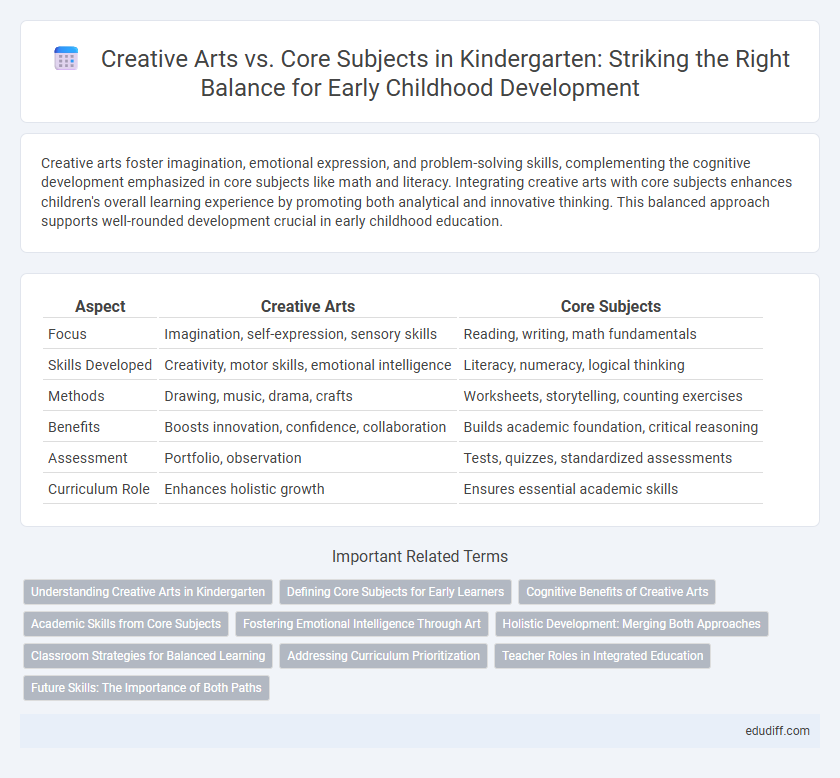Creative arts foster imagination, emotional expression, and problem-solving skills, complementing the cognitive development emphasized in core subjects like math and literacy. Integrating creative arts with core subjects enhances children's overall learning experience by promoting both analytical and innovative thinking. This balanced approach supports well-rounded development crucial in early childhood education.
Table of Comparison
| Aspect | Creative Arts | Core Subjects |
|---|---|---|
| Focus | Imagination, self-expression, sensory skills | Reading, writing, math fundamentals |
| Skills Developed | Creativity, motor skills, emotional intelligence | Literacy, numeracy, logical thinking |
| Methods | Drawing, music, drama, crafts | Worksheets, storytelling, counting exercises |
| Benefits | Boosts innovation, confidence, collaboration | Builds academic foundation, critical reasoning |
| Assessment | Portfolio, observation | Tests, quizzes, standardized assessments |
| Curriculum Role | Enhances holistic growth | Ensures essential academic skills |
Understanding Creative Arts in Kindergarten
Creative arts in kindergarten foster essential skills such as imagination, emotional expression, and fine motor development, which complement cognitive growth promoted by core subjects like literacy and numeracy. Engaging in activities like drawing, music, and role-play enhances neural connections and supports social-emotional learning critical for early childhood development. Understanding creative arts as a foundational component enriches holistic education, balancing academic rigor with innovative thinking and problem-solving abilities.
Defining Core Subjects for Early Learners
Core subjects for early learners in kindergarten typically include foundational skills such as literacy, numeracy, and basic science concepts essential for cognitive development. These subjects provide the building blocks for critical thinking, problem-solving, and communication skills necessary for academic success. Creative arts complement core subjects by fostering imagination and emotional expression, enhancing overall learning experiences.
Cognitive Benefits of Creative Arts
Creative arts in kindergarten significantly enhance cognitive development by fostering critical thinking, problem-solving skills, and neural connectivity. Engaging in activities such as drawing, music, and drama improves memory retention and attention span, complementing core subjects like math and literacy. Early exposure to creative arts promotes brain plasticity, enabling children to integrate diverse learning experiences crucial for overall academic success.
Academic Skills from Core Subjects
Core subjects in kindergarten, such as literacy, numeracy, and science, provide essential academic skills that build a strong foundation for future learning. These subjects enhance critical thinking, problem-solving, and language abilities crucial for academic success. While creative arts foster imagination and emotional expression, core academic skills ensure cognitive development and preparedness for elementary education.
Fostering Emotional Intelligence Through Art
Creative arts in kindergarten play a crucial role in fostering emotional intelligence by allowing children to express feelings non-verbally through drawing, painting, and music. Core subjects focus on cognitive skills such as literacy and numeracy, while art nurtures self-awareness, empathy, and emotional regulation. Integrating art with academic learning enhances overall emotional development, supporting social skills and mental well-being in early childhood education.
Holistic Development: Merging Both Approaches
Creative arts in kindergarten nurture imagination, emotional expression, and fine motor skills, complementing core subjects like literacy and numeracy that build foundational cognitive abilities. Integrating both approaches promotes holistic development by fostering critical thinking, problem-solving, and social-emotional growth simultaneously. This balanced curriculum supports well-rounded children better prepared for academic success and lifelong learning.
Classroom Strategies for Balanced Learning
Integrating creative arts with core subjects in kindergarten enhances cognitive development and fosters holistic learning. Strategies such as thematic units combining art projects with literacy or math activities engage multiple intelligences and reinforce key concepts. Maintaining a balanced curriculum through play-based learning and hands-on experiences supports both academic skills and creativity.
Addressing Curriculum Prioritization
Balancing creative arts with core subjects in kindergarten curricula enhances cognitive development and fosters critical thinking skills essential for early learners. Emphasizing creative arts alongside literacy and numeracy supports holistic growth, improving problem-solving abilities and emotional expression. Curriculum prioritization should integrate both areas to nurture well-rounded young minds prepared for future academic challenges.
Teacher Roles in Integrated Education
Teachers in kindergarten play a crucial role in integrating creative arts with core subjects by designing activities that foster both cognitive and artistic development. This approach enhances students' engagement and critical thinking by using music, visual arts, and drama to reinforce literacy, numeracy, and scientific concepts. By balancing creativity with foundational skills, educators support holistic learning that nurtures emotional expression and academic achievement simultaneously.
Future Skills: The Importance of Both Paths
Creative arts in kindergarten cultivate critical future skills such as innovation, problem-solving, and emotional intelligence that complement foundational knowledge in core subjects like math and literacy. Integrating both creative arts and core subjects supports a balanced skill set, fostering adaptability and lifelong learning essential for success in a rapidly evolving world. Developing these diverse competencies early prepares children to navigate complex challenges and thrive in future careers.
Creative arts vs Core subjects Infographic

 edudiff.com
edudiff.com